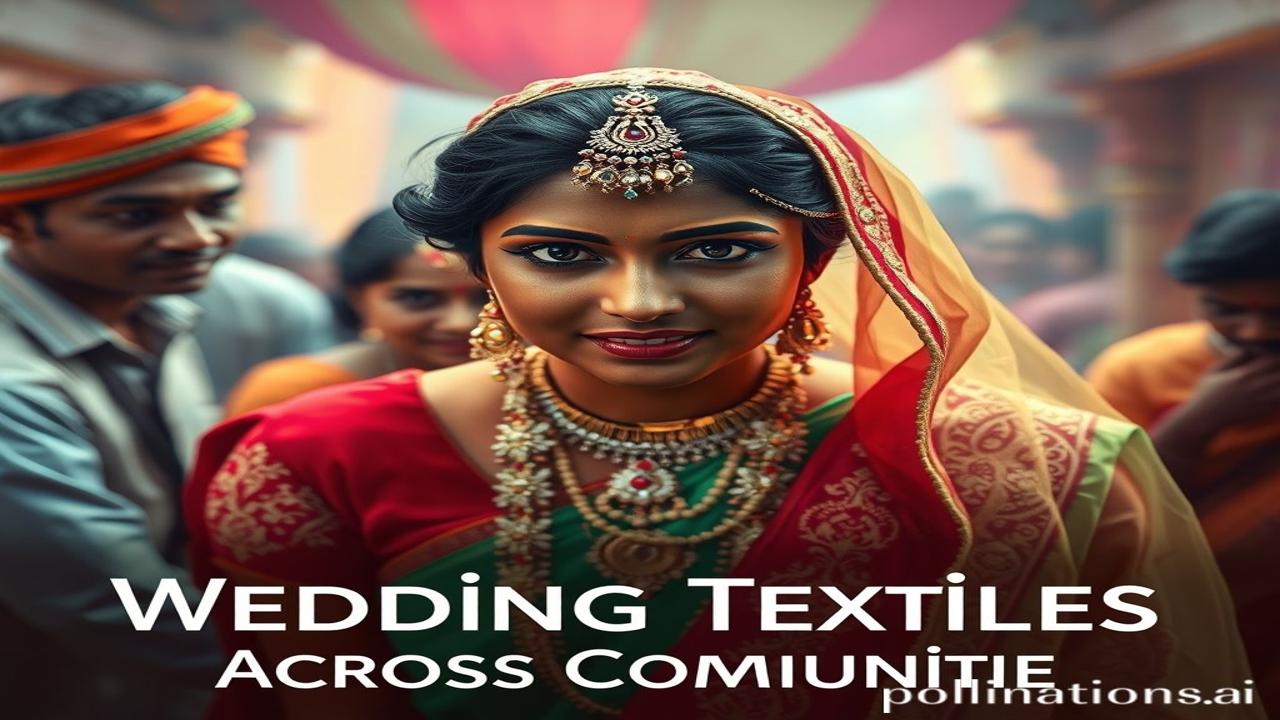Doli Sajao, Kahani Sunao: Wedding Textiles Across Communities – A Woven Legacy
Kabhi socha hai, uss shaadi ke jode mein kitni kahaniyan bandh hain? Not just of the bride and groom, but of generations past, of artists who poured their heart into every thread. Waqt ki dhool mein chhupi, yeh dastaan hai Bharat ki, jahaan har dhaage mein sanskriti basti hai. Let’s unravel the vibrant tapestry of wedding textiles across India, exploring the unique styles and stories woven into each community’s traditions.
Shaadi Ka Joda: Ek Itihaas, Ek Sanskruti
What are wedding textiles? Simply put, they are fabrics specially made or chosen for wedding ceremonies. But they are so much more! These are not just clothes; they are carriers of history, symbols of status, and declarations of identity. Their origin? It’s as ancient as our civilization itself. From the intricate brocades of the Mughal era to the simple cottons dyed in vibrant hues of tribal communities, wedding textiles are a window into India’s diverse past.
When and Where? Think Indus Valley Civilization. Archeological evidence suggests that textiles were highly valued, and though we don’t have exact wedding attire details, it’s likely that special fabrics played a role even then. Fast forward through the Maurya and Gupta periods, and we see references in literature and art to opulent silks and embellishments. Mughal influence brought further refinement and grandeur, especially in North India. Meanwhile, in the South, silk reigned supreme, with Kanjeevarams becoming synonymous with weddings. From Kashmir’s Pashminas to Assam’s Muga silk, every region contributed its unique craft.
Why so important? Because shaadi, my friends, is not just a union of two individuals; it’s a celebration of families, communities, and traditions. The wedding attire is the visual representation of this connection. It whispers stories of ancestral legacies, symbolizes the hopes and dreams for the future, and solidifies the cultural identity of the bride and groom. It’s dharohar, a legacy passed down through generations.
Zameeni Sach: Threads of Life, Woven Together
Imagine a weaver in Varanasi, painstakingly crafting a Banarasi silk sari for months. His hands, weathered with years of experience, move with practiced ease, each thread placed with precision. He knows this sari isn’t just a piece of cloth; it’s a family’s pride, a bride’s dream. Maybe his great-grandfather wove for the Mughal emperors, and the tradition continues through him.
“Beta, yeh sirf dhaaga nahi hai,” he tells his grandson, who is watching him work. “Yeh kala hai, yeh shakti hai. Ismein tumhare ancestors ka pyaar hai.”
Or picture a tribal woman in Rajasthan, carefully embroidering a ghagra with intricate mirror work. The vibrant colors reflect the desert landscape, the mirrors ward off evil spirits. She’s not just making a garment; she’s invoking blessings for the bride’s happiness and prosperity.
Ma Rukmini ne aaj naye kapde pehne, kyunki mandir mein utsav tha. Unka lehnga, haath se bana hua, aur har mirror mein unki zindagi ki kahani chupi thi.
These are just glimpses into the lives intertwined with wedding textiles. Rulers commissioned the finest fabrics to showcase their wealth and power, artisans dedicated their lives to perfecting their craft, and common people saved for years to afford a beautiful wedding outfit. Their dreams, fears, and joys are all woven into these threads.
Dharohar Aur Pehchan: Echoes of the Past in the Present
Even today, the importance of wedding textiles remains undiminished. From the Bollywood stars flaunting designer lehengas to the traditional families cherishing heirloom saris, the legacy continues. The Kanjeevaram silk still signifies South Indian bridal elegance, the Banarasi brocade continues to be a symbol of North Indian opulence, and the paithani silk maintains its Marathi charm.
These textiles aren’t just remnants of the past; they are vibrant threads woven into the fabric of modern India. They represent Bharatiyata, the essence of Indianness, and contribute to our national identity. We see them in contemporary designs, fusion fashion, and even in art installations, proving that tradition can be both timeless and innovative.
Mazedar Tathya: Did You Know…?
Log samajhte hain ki only rich log hi silk kharidte the…lekin asli sach yeh hai ki cottons were also richly decorated and highly valued across communities! Dyeing techniques with natural colors, intricate embroidery, and the skill of the weaver made even simple cotton garments a work of art, accessible to a wider section of society. Also, the concept of a “white wedding” is relatively new in many Indian communities. Traditionally, colors like red, yellow, and green symbolized auspiciousness and prosperity.
Drishya Aur Bhavnaayein: A Sensory Symphony
Imagine walking into a wedding procession. The air smells of jasmine and sandalwood, mingling with the sweet scent of mithai. The sound of shehnai fills the air, punctuated by the rhythmic beat of the dhol. The bride, draped in a shimmering silk sari, walks with hesitant grace, her face veiled behind a delicate ghunghat. The temple walls, ancient and worn, seem to echo with the blessings of generations past. The touch of the silk on your skin is smooth and luxurious, a reminder of the rich history and cultural significance woven into every thread.
Antim Vichar: A Timeless Thread
Shaadi ka joda, sirf ek kapda nahi, ek ehsaas hai. It is not just clothing; it’s a chronicle of our past, a celebration of our present, and a promise for our future.
“वस्त्रं भूषणं रूपं सौभाग्यं कुलशीलनम् |
सर्वे भवन्ति सुभगे यस्या नार्याः पतिव्रतम् ||”
(Vastram bhushanam roopam saubhagyam kulashilanam |
Sarve bhavanti subhage yasya naryah pativratam ||)
(Clothing, adornment, beauty, good fortune, family lineage, and character—all these become auspicious for a woman who is devoted to her husband.)
May the threads of tradition continue to bind us together, weaving a vibrant and resilient future for generations to come.
